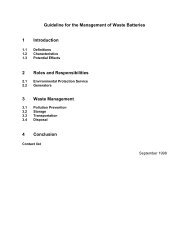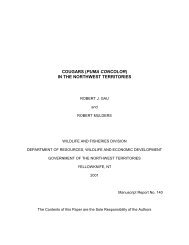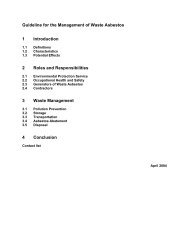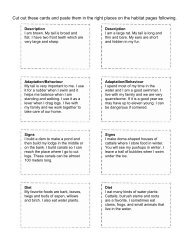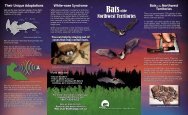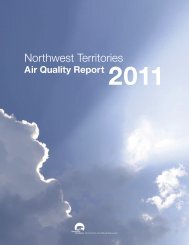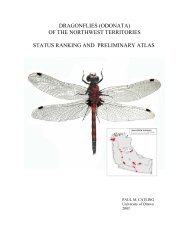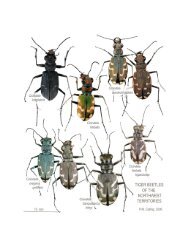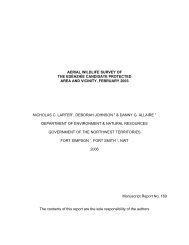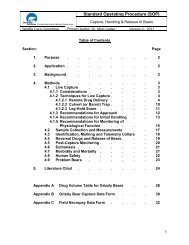Guideline for the Management of Waste Lead and Lead Paint
Guideline for the Management of Waste Lead and Lead Paint
Guideline for the Management of Waste Lead and Lead Paint
Create successful ePaper yourself
Turn your PDF publications into a flip-book with our unique Google optimized e-Paper software.
<strong>Guideline</strong> <strong>for</strong> <strong>the</strong> <strong>Management</strong> <strong>of</strong><br />
<strong>Waste</strong> <strong>Lead</strong> <strong>and</strong> <strong>Lead</strong> <strong>Paint</strong><br />
1 Introduction<br />
1.1 Definitions<br />
1.2 Potential Effects<br />
1.3 Common Sources <strong>of</strong> <strong>Lead</strong><br />
2 Roles <strong>and</strong> Responsibilities<br />
2.1 Environmental Protection Service<br />
2.2 Occupational Health <strong>and</strong> Safety<br />
2.3 Public Health <strong>and</strong> Safety<br />
2.4 Generators<br />
2.5 S<strong>and</strong> Blasting Contractors<br />
3 <strong>Waste</strong> <strong>Management</strong><br />
3.1 Pollution Prevention<br />
Containment <strong>of</strong> <strong>Paint</strong> <strong>and</strong> Abrasive Debris<br />
3.3 Recovery <strong>of</strong> <strong>Paint</strong> <strong>and</strong> Abrasive Debris<br />
3.4 Storage<br />
3.5 Transportation<br />
3.6 Disposal<br />
4 Agency In<strong>for</strong>mation<br />
4.1 Key to Acronyms<br />
4.2 Agency Contacts<br />
5 Bibliography<br />
April 2004<br />
- 1 -
<strong>Guideline</strong> <strong>for</strong> <strong>the</strong> <strong>Management</strong> <strong>of</strong><br />
<strong>Waste</strong> <strong>Lead</strong> <strong>and</strong> <strong>Lead</strong> <strong>Paint</strong><br />
1 Introduction<br />
<strong>Waste</strong> products that contain lead are considered contaminants under <strong>the</strong> Northwest<br />
Territories’Environmental Protection Act (EPA) <strong>and</strong> must be managed as a hazardous<br />
waste. This guideline presents a brief introduction into <strong>the</strong> management <strong>of</strong> waste lead<br />
<strong>and</strong> lead containing products. It is intended as a source <strong>of</strong> basic in<strong>for</strong>mation <strong>and</strong> does<br />
not replace <strong>the</strong> existing legislation, which is referenced throughout.<br />
Historically, lead was used in many commercial products including: paint, gasoline,<br />
insecticides <strong>and</strong> batteries, to name a few. We now know that products <strong>and</strong> structures<br />
painted with leaded paint are a source <strong>of</strong> health <strong>and</strong> environmental contaminants.<br />
<strong>Lead</strong> in gasoline <strong>and</strong> household paints is now restricted by federal legislation, as are<br />
lead pellet shotgun shells used <strong>for</strong> hunting migratory birds.<br />
<strong>Lead</strong> is toxic to living organisms <strong>and</strong> if released into <strong>the</strong> environment can<br />
bioaccumulate <strong>and</strong> enter <strong>the</strong> food chain. Products that contain lead in excess <strong>of</strong> 600<br />
parts per million (0.06% by weight) are considered hazardous waste <strong>and</strong> shall be<br />
managed in accordance with this guideline.<br />
This document should be read in conjunction with <strong>the</strong> <strong>Guideline</strong> <strong>for</strong> <strong>the</strong> General<br />
<strong>Management</strong> <strong>of</strong> Hazardous <strong>Waste</strong> In The NWT (referred to as <strong>the</strong> General <strong>Guideline</strong>),<br />
<strong>and</strong>, <strong>the</strong> <strong>Guideline</strong> <strong>for</strong> <strong>the</strong> <strong>Management</strong> <strong>of</strong> <strong>Waste</strong> Institutional/Commercial <strong>and</strong><br />
Industrial Chemicals. <strong>Management</strong> <strong>of</strong> lead acid batteries is addressed under <strong>the</strong><br />
<strong>Guideline</strong> <strong>for</strong> <strong>the</strong> <strong>Management</strong> <strong>of</strong> <strong>Waste</strong> Batteries.<br />
Section 2.2 <strong>of</strong> <strong>the</strong> EPA gives <strong>the</strong> Minister <strong>of</strong> Resources, Wildlife <strong>and</strong> Economic<br />
Development <strong>the</strong> authority to develop, coordinate <strong>and</strong> administer <strong>the</strong>se guidelines.<br />
O<strong>the</strong>r Acts <strong>and</strong> Regulations are also in place to protect workers <strong>and</strong> <strong>the</strong> public from <strong>the</strong><br />
effects <strong>of</strong> lead exposure. Please contact <strong>the</strong> appropriate agency be<strong>for</strong>e proceeding on<br />
projects involving waste lead <strong>and</strong> lead paint.<br />
1.1 Definitions<br />
Controlled product<br />
Any product, material or substance specified under paragraph<br />
15(1)(a) <strong>of</strong> <strong>the</strong> Hazardous Products Act (Canada) <strong>and</strong> its<br />
regulations.<br />
- 1 -
Fume<br />
Generator<br />
The smoke-like vapour given <strong>of</strong>f from heated metals.<br />
The owner or person in charge, management or control <strong>of</strong> a<br />
hazardous waste at <strong>the</strong> time it was generated, or a facility that<br />
generates hazardous waste.<br />
<strong>Lead</strong> amended paint Structural coatings containing greater than 600 parts per million<br />
(0.06% by weight) lead.<br />
Metallic lead<br />
Organic lead<br />
Inorganic lead<br />
The solid metal <strong>for</strong>m <strong>of</strong> lead, bluish-white or silvery-gray in<br />
colour. By weight, it is heavy <strong>and</strong> is also s<strong>of</strong>t, which makes it<br />
ductile <strong>and</strong> malleable. O<strong>the</strong>r desirable properties are that it is a<br />
poor conductor <strong>of</strong> electricity, it has a low melting point <strong>and</strong> it is<br />
resistant to corrosion. Uses include: ammunition, electrical<br />
storage batteries (lead acid batteries), lead solder, pipes, sheaths<br />
<strong>for</strong> electrical cable <strong>and</strong> radiation shields.<br />
In general, lead combined with a chemical compound containing<br />
carbon. These chemical compounds are usually in powder,<br />
crystal, paste or liquid <strong>for</strong>m, depending on <strong>the</strong> compound. Uses<br />
include tetraethyl lead (used as an anti-knock agent in gasoline),<br />
tetramethyl lead, lead naphthanate, stearate <strong>and</strong> oleate.<br />
In general, lead substances that do not contain compounds <strong>of</strong><br />
carbon, hydrocarbons or derivatives. These chemical compounds<br />
are usually found in powder or crystal <strong>for</strong>m, but some are liquid.<br />
Uses include: frits, glasses, insecticides, wood preservatives,<br />
specific paints, pigments, plastics <strong>and</strong> rubber compounds.<br />
Transport authority The regulations controlling <strong>the</strong> management <strong>of</strong> hazardous waste<br />
under specified modes <strong>of</strong> transport. They include:<br />
Road <strong>and</strong> rail Transportation <strong>of</strong> Dangerous Goods Act (TDGA)<br />
<strong>and</strong> Regulations (TDGR)<br />
Air<br />
Marine<br />
International Civil Aviation Organization (ICAO)<br />
Technical Instructions<br />
International Maritime Dangerous Goods Code<br />
(IMDG)<br />
- 2 -
1.2 Potential Effects<br />
Metallic lead<br />
Fumes – <strong>Lead</strong> fumes inhaled during melting operations pose an acute health risk to<br />
people. They can also be an accumulative poison <strong>and</strong> if exposure continues, chronic<br />
health symptoms <strong>and</strong> disability occur. The major areas affected are <strong>the</strong> nervous<br />
system, blood system <strong>and</strong> kidneys.<br />
Dust – Metallic lead can also enter <strong>the</strong> body through breathing dust from activities such<br />
as s<strong>and</strong>blasting <strong>of</strong> lead paint. If inhaled, lead particles smaller than 10 microns (onemillionth<br />
meter) can move directly into <strong>the</strong> bloodstream through <strong>the</strong> lungs.<br />
Ano<strong>the</strong>r source <strong>of</strong> occupational lead exposure is by accidental ingestion as workers<br />
h<strong>and</strong>le cigarettes or food when <strong>the</strong>ir h<strong>and</strong>s are contaminated with lead dust.<br />
Contact with Water – Metallic lead is not water soluble between <strong>the</strong> pH range <strong>of</strong> 5 <strong>and</strong><br />
12. If prevented from contacting water or water vapor, it will not leach into <strong>the</strong><br />
environment.<br />
Organic lead<br />
These chemical compounds are generally toxic by inhalation, ingestion <strong>and</strong> skin<br />
absorption. With skin absorption being <strong>the</strong> primary route <strong>of</strong> exposure, it readily<br />
penetrates <strong>the</strong> skin directly or is dissolved in oils, which can penetrate <strong>the</strong> skin. Many<br />
organic lead compounds are also flammable or carcinogenic. Ingestion <strong>of</strong> leaded paint<br />
dust <strong>and</strong> chips has been shown to retard mental <strong>and</strong> physical growth in children.<br />
Inorganic lead<br />
These chemical compounds are generally toxic by inhalation or ingestion. Skin<br />
absorption is generally insignificant <strong>for</strong> both metallic <strong>and</strong> inorganic lead.<br />
Hazardous Effect Ratings<br />
inhalation ingestion skin absorption<br />
Metallic lead<br />
High<br />
(extreme when<br />
heated)<br />
Medium<br />
Low<br />
Organic lead Medium High High<br />
Inorganic lead Low High Low<br />
- 3 -
1.3 Common Sources <strong>of</strong> <strong>Lead</strong><br />
Metallic lead<br />
Automotive industry:<br />
Construction industry:<br />
Electronic industry:<br />
Resource industry:<br />
Printing industry:<br />
wheel weights, bearings, friction additive in clutch facings<br />
<strong>and</strong> brakes, storage batteries<br />
flashing, pipe, sheeting, counterweights, paint additives<br />
cathode-ray tubes, radiation shielding, solder<br />
fishing sinkers, rifle bullets, backstops at rifle <strong>and</strong> pistol<br />
ranges<br />
letter blocks<br />
Organic lead<br />
Miscellaneous:<br />
Automotive industry:<br />
Inorganic lead<br />
Oil field construction:<br />
Automotive industry:<br />
Miscellaneous:<br />
paint, insecticides, fungicides, chemical reagents, gasoline<br />
additives, pigments, dyes<br />
spent glycol solution removed from cooling systems with<br />
heat exchangers made from alloys containing lead as an<br />
adhesive<br />
joining compound (pipe dope)<br />
ceramic products, paints, rubbers, dyes, corrosion inhibiting<br />
pigment in paints <strong>and</strong> primers<br />
manufacture <strong>of</strong> explosives, blasting caps, matches <strong>and</strong><br />
pyrotechnics, chemical reagents, pigments, dyes<br />
2 Roles <strong>and</strong> Responsibilities<br />
2.1 Environmental Protection<br />
The Environmental Protection Service (EPS) is part <strong>of</strong> <strong>the</strong> Government <strong>of</strong> <strong>the</strong><br />
Northwest Territories’(GNWT) Department <strong>of</strong> Resources, Wildlife <strong>and</strong> Economic<br />
Development. EPS is <strong>the</strong> agency responsible <strong>for</strong> control <strong>of</strong> how contaminants are<br />
discharged <strong>and</strong> <strong>the</strong>ir impact on <strong>the</strong> natural environment. It is responsible <strong>for</strong> ensuring<br />
environmentally acceptable management procedures, emission levels <strong>and</strong> disposal<br />
methods are maintained in <strong>the</strong> NWT.<br />
EPS programs are applied primarily to Commissioner’s L<strong>and</strong>, municipal l<strong>and</strong>s or l<strong>and</strong>s<br />
involving GNWT activities. Legislative authority is provided by <strong>the</strong> Environmental<br />
Protection Act (EPA) <strong>and</strong> Pesticide Act. Contact EPS <strong>for</strong> a listing <strong>of</strong> relevant<br />
regulations <strong>and</strong> guidelines or visit <strong>the</strong> web site at www.gov.nt.ca/RWED/eps/leg.htm.<br />
- 4 -
2.2 Occupational Health <strong>and</strong> Safety<br />
The Prevention Services Division <strong>of</strong> <strong>the</strong> Workers’Compensation Board regulates<br />
worker protection from air-borne lead <strong>and</strong> o<strong>the</strong>r toxic materials. The General Safety<br />
Regulations, under <strong>the</strong> Northwest Territories Safety Act, require that employee<br />
exposure to hazardous air-borne dust be maintained below specified levels. The<br />
specified exposure levels correspond to <strong>the</strong> type <strong>of</strong> materials in use <strong>and</strong> are listed in<br />
<strong>the</strong> Schedule to <strong>the</strong> regulations.<br />
Contact <strong>the</strong> Prevention Services Division <strong>for</strong> regulations <strong>and</strong> procedures to prevent<br />
worker exposure to toxic materials. This includes lead abatement projects (leaded<br />
paint removal), h<strong>and</strong>ling products containing lead or <strong>the</strong> grinding, cutting or welding <strong>of</strong><br />
products coated in leaded paint. Also included are worker protection measures <strong>for</strong> use<br />
during clean up <strong>of</strong> backstops at rifle <strong>and</strong> pistol ranges.<br />
2.3 Public Health <strong>and</strong> Safety<br />
The Department <strong>of</strong> Health <strong>and</strong> Social Services has <strong>the</strong> authority <strong>for</strong> public health <strong>and</strong><br />
safety. The General Sanitation Regulations, under <strong>the</strong> authority <strong>of</strong> <strong>the</strong> Public Health<br />
Act, is <strong>the</strong> legislation used to protect <strong>the</strong> public from materials or activities that are<br />
injurious to public health. As an example, lead abatement projects, which use s<strong>and</strong> or<br />
abrasive blasting to remove leaded paint from steel structures, have <strong>the</strong> potential to<br />
adversely impact on public health. Responsible management <strong>of</strong> such projects means<br />
consulting with an Environmental Health Officer.<br />
2.4 Generators<br />
The responsibility <strong>for</strong> proper waste management rests with <strong>the</strong> generator<br />
<strong>and</strong> should be considered part <strong>of</strong> <strong>the</strong> “cost <strong>of</strong> doing business”.<br />
Identification <strong>of</strong> lead in organic <strong>and</strong> inorganic lead-based chemicals is accomplished by<br />
review <strong>of</strong> <strong>the</strong> Material Safety Data Sheets (MSDS), which must accompany all<br />
controlled products distributed in Canada. Manufacturers or <strong>the</strong>ir product distributors<br />
are required to provide an MSDS with <strong>the</strong>ir products.<br />
Alternate resources may be required to identify older products suspected <strong>of</strong> containing<br />
lead. Analysis by an accredited laboratory is one option. Laboratories can be<br />
contacted through <strong>the</strong>ir associations listed in <strong>the</strong> General <strong>Guideline</strong>, Appendix Il.<br />
- 5 -
<strong>Management</strong> options <strong>for</strong> lead-containing chemicals (organic or inorganic) are<br />
addressed in <strong>the</strong> <strong>Guideline</strong> <strong>for</strong> <strong>the</strong> <strong>Management</strong> <strong>of</strong> <strong>Waste</strong> Institutional - Commercial<br />
<strong>and</strong> Industrial Chemicals. The General <strong>Guideline</strong> should also be consulted <strong>for</strong><br />
generator responsibilities.<br />
<strong>Waste</strong>s Fur<strong>the</strong>r Addressed<br />
For <strong>the</strong> purpose <strong>of</strong> this guideline, only <strong>the</strong> following wastes containing lead <strong>and</strong> <strong>the</strong>ir<br />
management are fur<strong>the</strong>r addressed:<br />
- lead amended paint<br />
- s<strong>and</strong> or soils used as backstops at rifle <strong>and</strong> pistol ranges<br />
- soils containing lead at steel structure manufacturing/construction or repair yards<br />
It is <strong>the</strong> owner’s responsibility to identify <strong>the</strong> presence <strong>of</strong> lead. Common examples <strong>of</strong><br />
where lead amended paint is found include:<br />
- barges <strong>and</strong> ships, heavy equipment<br />
- steel fabrication/painting facilities<br />
- pipelines<br />
- fuel storage tanks<br />
- steel bridges<br />
- steel towers<br />
- grain storage bins<br />
- rail cars<br />
The owner is responsible <strong>for</strong> evaluating painted steel structures or fabrication/<br />
demolition sites <strong>for</strong> <strong>the</strong> presence <strong>of</strong> lead. <strong>Paint</strong>ed tanks or o<strong>the</strong>r steel structures should<br />
be sampled <strong>for</strong> confirmation <strong>of</strong> lead amended paint <strong>and</strong> lead concentration prior to<br />
s<strong>and</strong>blasting or o<strong>the</strong>r maintenance activities.<br />
In addition to lead, industrial or steel coatings such as paint <strong>and</strong> paint primer, may<br />
contain o<strong>the</strong>r contaminants to be aware <strong>of</strong> such as arsenic, polychlorinated biphenyls<br />
(PCBs), cadmium, chromium, copper, magnesium <strong>and</strong> mercury. These are toxic<br />
substances if inhaled or ingested.<br />
<strong>Paint</strong> Samples<br />
A paint sample should be collected from tightly adhered paint <strong>and</strong> comprised <strong>of</strong> all<br />
layers <strong>of</strong> paint, from a one square inch area (2.5 cm). Make sure to scrape down to <strong>the</strong><br />
metal, being careful not to include any metal in <strong>the</strong> sample. A plastic bag is an<br />
adequate container. The paint should <strong>the</strong>n be analyzed, at <strong>the</strong> owner’s expense, at an<br />
accredited laboratory. The analytical data should <strong>the</strong>n be <strong>for</strong>warded to EPS.<br />
- 6 -
Rifle Range Backstop Samples<br />
Sample collection from rifle range backstops should be done by following <strong>the</strong><br />
procedures provided by an accredited analytical laboratory to ensure representative<br />
samples are obtained. Personal protective equipment may be required, consult WCB<br />
Safety Officers.<br />
Soil Samples<br />
In<strong>for</strong>mation on <strong>the</strong> procedures <strong>for</strong> sampling lead in soil are available from accredited<br />
analytical laboratories.<br />
Important Analysis Note<br />
Due to <strong>the</strong> complex chemical relationship <strong>of</strong> lead <strong>and</strong> iron, <strong>the</strong> Toxic Characteristic<br />
Leaching Procedure (TCLP) is not acceptable <strong>for</strong> lead analysis. Iron masks TCLP<br />
detection <strong>of</strong> lead. The only accepted lead analysis is called “Total <strong>Lead</strong>”.<br />
2.5 S<strong>and</strong>blasting Contractors<br />
Repainting <strong>of</strong> steel structures <strong>for</strong> rust protection usually involves s<strong>and</strong>blasting <strong>of</strong> <strong>the</strong><br />
deteriorated paint, in preparation <strong>for</strong> a new coating <strong>of</strong> primer <strong>and</strong> paint. <strong>Paint</strong>ed tanks<br />
or o<strong>the</strong>r steel structures should be sampled <strong>for</strong> confirmation <strong>of</strong> lead <strong>and</strong> lead<br />
concentration prior to s<strong>and</strong>blasting or o<strong>the</strong>r maintenance activities. Consultation with<br />
<strong>the</strong> appropriate regulatory agencies prior to starting lead abatement projects is <strong>the</strong><br />
responsible work strategy to prevent public, worker <strong>and</strong> environmental impairment.<br />
S<strong>and</strong>blasting Media Hazards<br />
The International Agency <strong>for</strong> Research on Cancer, established by <strong>the</strong> World Health<br />
Organization in 1995, classified crystalline (free) silica as carcinogenic to humans<br />
when inhaled in <strong>the</strong> <strong>for</strong>m <strong>of</strong> quartz or cristobalite from occupational sources. Selection<br />
<strong>of</strong> a non-hazardous s<strong>and</strong>blasting medium will reduce <strong>the</strong> hazard dust levels that need<br />
to be controlled <strong>and</strong> managed as hazardous wastes.<br />
Non-carcinogenic s<strong>and</strong> types should be specified <strong>for</strong> s<strong>and</strong>blasting. Alternately,<br />
products like nutshells, solid carbon dioxide or baking soda-based abrasives should be<br />
used to remove deteriorated paint. Ultra-high pressure water jetting <strong>of</strong> leaded paint is<br />
recommended as paint <strong>and</strong> abrasive dusts are not produced. Names <strong>of</strong> alternate<br />
blasting media suppliers are available by contacting <strong>the</strong> paint associations listed in this<br />
document under section 4 Agency Contacts.<br />
- 7 -
3 <strong>Waste</strong> <strong>Management</strong><br />
Minimizing or avoiding <strong>the</strong> creation <strong>of</strong> pollutants <strong>and</strong> wastes can be more<br />
effective in protecting <strong>the</strong> environment than treating or cleaning <strong>the</strong>m up<br />
after <strong>the</strong>y have been created. -- Canadian Council <strong>of</strong> Ministers <strong>of</strong> <strong>the</strong> Environment<br />
3.1 Pollution Prevention<br />
“Pollution prevention” methods eliminate <strong>the</strong> creation <strong>of</strong> environmental contaminants by<br />
preventing <strong>the</strong> waste from being created in <strong>the</strong> first place. “Pollution control” methods<br />
are geared towards treating <strong>the</strong> waste after it’s created.<br />
Scientific advances in <strong>the</strong> paint <strong>and</strong> coatings industry have resulted in <strong>the</strong> development<br />
<strong>of</strong> superior paints <strong>and</strong> coatings that provide corrosion resistance on steel <strong>and</strong> o<strong>the</strong>r<br />
structures. <strong>Lead</strong>ed paints are no longer required.<br />
Approximately 500 protective coatings <strong>and</strong> linings are available to provide protection,<br />
without lead, <strong>for</strong> commercial <strong>and</strong> industrial structures. These coatings have been<br />
developed <strong>for</strong> five general exposure environments (categories) <strong>and</strong> special purpose<br />
materials i.e. exterior service, flooring, immersion service, buried pipe, buried<br />
structures <strong>and</strong> specialty function.<br />
Coating subcategories that list more detailed exposure conditions; types <strong>of</strong> structures,<br />
heat resistance etc., as well as <strong>the</strong> generic coatings types (e.g. Acrylic, Epoxy, Zincrich,<br />
Polyurethane. etc.); <strong>and</strong> <strong>the</strong> recommended uses, are available in The Journal <strong>of</strong><br />
Protective Coatings <strong>and</strong> Linings (ISSN 8755-1985).<br />
Technology Publishing Company in cooperation with <strong>the</strong> Steel Structures <strong>Paint</strong>ing<br />
Council publishes <strong>the</strong> Journal <strong>of</strong> Protective Coatings <strong>and</strong> Linings on a monthly basis.<br />
The RWED Library has available, <strong>for</strong> viewing, all monthly issues <strong>of</strong> <strong>the</strong> journal from<br />
1994. Coating manufacturers, coating consultants <strong>and</strong> new technologies are also listed.<br />
Pollution prevention methods <strong>for</strong> structures with leaded paint include:<br />
- repainting without complete paint removal<br />
- spot painting, overcoating, zone coating, or deferring painting entirely<br />
- alternatives to s<strong>and</strong>blasting such as cleaning with ultra-high pressure water jets,<br />
vacuum power tools, rotary power tools, vacuum head needle guns, <strong>and</strong> chemical<br />
strippers<br />
Because <strong>of</strong> potential health <strong>and</strong> environmental hazards, s<strong>and</strong>blasting should only be<br />
considered after a thorough evaluation <strong>of</strong> <strong>the</strong> structure <strong>and</strong> <strong>the</strong> pollution prevention<br />
options.<br />
- 8 -
Containment <strong>of</strong> <strong>Paint</strong> <strong>and</strong> Abrasive Debris<br />
Regardless <strong>of</strong> <strong>the</strong> leaded paint removal method, total containment <strong>of</strong> <strong>the</strong> leaded paint<br />
<strong>and</strong> abrasive debris or paint strippers is a requirement <strong>of</strong> <strong>the</strong> Environmental Protection<br />
Act.<br />
A containment system must be used to enclose an entire work area or paint removal<br />
tool. It includes cover panels, screens, scaffolds, supports <strong>and</strong> shrouds. The purpose<br />
<strong>of</strong> such a system is to minimize <strong>and</strong> prevent any generated debris from entering <strong>the</strong><br />
environment, <strong>and</strong> to facilitate <strong>the</strong> controlled collection <strong>of</strong> <strong>the</strong> debris <strong>for</strong> disposal.<br />
Containment systems may also employ <strong>the</strong> use <strong>of</strong> ground covers or water booms.<br />
Containment devices include:<br />
- drop sheets or tarps<br />
- shrouding or free-hanging enclosures<br />
- total structure enclosures<br />
- negative pressure containment<br />
In general, high-pressure water jetting <strong>for</strong> paint removal is fast, less expensive than<br />
o<strong>the</strong>r methods <strong>and</strong> generates minimal waste. Also, worker safety is increased, as lead<br />
paint dust is not created. However, <strong>the</strong> water must be filtered to remove all paint<br />
residues <strong>and</strong> it must be tested <strong>for</strong> lead prior to discharge.<br />
Filter fabric is used to remove <strong>the</strong> paint from <strong>the</strong> water. The filter fabric <strong>and</strong> paint<br />
residues require containment <strong>and</strong> managed as hazardous waste. The remaining water<br />
requires testing to ensure no more than 5 mg/l (ppm) <strong>of</strong> total lead remain prior to<br />
discharge to <strong>the</strong> environment or sewage lagoon (<strong>Guideline</strong> <strong>for</strong> Industrial <strong>Waste</strong><br />
Discharges in <strong>the</strong> NWT). Water analysis is required by EPS prior to receiving<br />
discharge authorization.<br />
3.3 Recovery <strong>of</strong> Abrasive <strong>and</strong> <strong>Paint</strong> Debris<br />
Collection <strong>of</strong> paint residues must be undertaken frequently to prevent dispersal by wind<br />
or by s<strong>and</strong>blasting operations. A vacuum is recommended as a rapid on-site collection<br />
method. Sweeping <strong>and</strong> shoveling are also used <strong>for</strong> cleaning abrasives from <strong>the</strong> ground<br />
covers.<br />
Collection containers must not allow s<strong>and</strong>blasting wastes to spill or leak into <strong>the</strong><br />
environment. Open-top drums or strong plastic bags are examples <strong>of</strong> materials that<br />
can be used <strong>for</strong> waste collection <strong>and</strong> storage, pending disposal. Debris collection<br />
techniques include:<br />
- capture from surface at point <strong>of</strong> cleaning (vacuum blasting)<br />
- capture from containment enclosures (sweeping, vacuuming)<br />
- 9 -
- capture from ground or over water (tarps, barges)<br />
- channeling debris to specified collection points<br />
3.4 Storage<br />
<strong>Lead</strong> compounds or materials contaminated with lead must be stored in a safe <strong>and</strong><br />
secure manner. They should be in leakpro<strong>of</strong> containers to prevent release into <strong>the</strong><br />
environment. Depending on <strong>the</strong> material, <strong>the</strong> packaging should be designed to prevent<br />
contact with precipitation or it should be stored indoors.<br />
3.5 Transportation<br />
<strong>Lead</strong> waste transported to a recycling, treatment, disposal or management facility must<br />
be properly classified, packaged, labelled <strong>and</strong> manifested, as required by <strong>the</strong> transport<br />
authority (air, road, rail, marine), as <strong>the</strong> case may be. Specific requirements <strong>for</strong> waste<br />
generators, carriers <strong>and</strong> receivers are detailed in <strong>the</strong> General <strong>Guideline</strong>.<br />
Registration numbers, waste manifests <strong>and</strong> registered hazardous waste carrier lists are<br />
available from EPS. <strong>Waste</strong> management contacts are listed in <strong>the</strong> General <strong>Guideline</strong>.<br />
For road transportation purposes, dry leaded paint waste or lead contaminated<br />
soils/materials from pistol <strong>and</strong> rifle range backstops can be classified as shown below.<br />
Shipping Name:<br />
Leachable Toxic <strong>Waste</strong> (L17)<br />
Classification: 9.3<br />
P.I.N.: UN9500<br />
Packing Group: III<br />
Chemical stripping <strong>of</strong> lead paint generates both a corrosive waste <strong>and</strong> a lead leachable<br />
waste. The disposal options are <strong>the</strong> same as that <strong>for</strong> <strong>the</strong> dry wastes generated by<br />
mechanical means. However, <strong>the</strong> shipping requirements must reflect <strong>the</strong> additional<br />
hazards <strong>of</strong> being corrosive.<br />
The shipping requirements will be based on <strong>the</strong> chemical characteristics <strong>of</strong> <strong>the</strong><br />
chemical stripper used to remove <strong>the</strong> paint. Consultation with <strong>the</strong> TDGR, IATA or<br />
IMDG is recommended.<br />
- 10 -
3.6 Disposal<br />
Metallic <strong>Lead</strong><br />
Disposal <strong>of</strong> metallic lead, such as wheel weights or sheeting, can be done by shipping<br />
to a lead or metals foundry, or a metals recycler (metallic lead is not listed in <strong>the</strong><br />
Transportation <strong>of</strong> Dangerous Goods Act or regulations).<br />
Inorganic <strong>and</strong> Organic <strong>Lead</strong> Chemical <strong>Waste</strong><br />
<strong>Management</strong> is addressed in <strong>the</strong> <strong>Guideline</strong> <strong>for</strong> <strong>the</strong> <strong>Management</strong> <strong>of</strong> <strong>Waste</strong> Institution -<br />
Commercial <strong>and</strong> Industrial Chemicals.<br />
<strong>Lead</strong>ed <strong>Paint</strong>/Soils<br />
Disposal options <strong>for</strong> leaded paint <strong>and</strong> s<strong>and</strong>blast residue, <strong>and</strong> lead contaminated<br />
soils/materials from pistol <strong>and</strong> rifle range backstops include transport to a registered<br />
hazardous waste disposal facility, or a lead or metals foundry. The receiving facility<br />
must be registered in <strong>the</strong> receiving province or territory <strong>and</strong> approved to manage that<br />
waste.<br />
Names <strong>of</strong> recycling or disposal companies are available by contacting <strong>the</strong> waste<br />
management associations listed in Appendix II <strong>of</strong> <strong>the</strong> General <strong>Guideline</strong>. Generator<br />
registration numbers, waste manifests <strong>and</strong> registered hazardous waste carrier lists are<br />
available from <strong>the</strong> Environmental Protection Service.<br />
Scientific advances in waste product stabilization <strong>and</strong> solidification utilizing cement,<br />
flyash, zeolites, etc., which chemically bind <strong>the</strong> lead <strong>and</strong> prevent environmental release<br />
are presently under review. EPS may approve <strong>the</strong> method, subject to conditions, if<br />
leachate test results are in accordance with <strong>the</strong> <strong>Guideline</strong> <strong>for</strong> Industrial <strong>Waste</strong><br />
Discharges in <strong>the</strong> NWT <strong>and</strong> amendments.<br />
If s<strong>and</strong>blast medium contains iron, <strong>the</strong> Toxic Characteristic Leaching Procedure (TCLP)<br />
cannot be used to meet requirements <strong>of</strong> <strong>the</strong> <strong>Guideline</strong> <strong>for</strong> Industrial <strong>Waste</strong> Discharges<br />
in <strong>the</strong> NWT.<br />
Consideration will be given to proposals <strong>for</strong> alternate management methods that<br />
provide a level <strong>of</strong> environmental protection equivalent to those discussed in this<br />
guideline.<br />
- 11 -
4 Agency In<strong>for</strong>mation<br />
4.1 Key to Acronyms<br />
EPA<br />
EPS<br />
GNWT<br />
IATA<br />
ICAO<br />
IMDG<br />
MSDS<br />
SSPC<br />
TCLP<br />
TDGA<br />
TDGR<br />
General<br />
<strong>Guideline</strong><br />
Environmental Protection Act<br />
Environmental Protection Service<br />
Government <strong>of</strong> <strong>the</strong> Northwest Territories<br />
International Air Transportation Association<br />
International Civil Aviation Organization<br />
International Maritime Dangerous Goods Code<br />
Material Safety Data Sheets<br />
Steel Structures <strong>Paint</strong>ing Council<br />
Toxic Characteristic Leaching Procedure<br />
Transportation <strong>of</strong> Dangerous Goods Act<br />
Transportation <strong>of</strong> Dangerous Goods Regulations<br />
<strong>Guideline</strong> <strong>for</strong> <strong>the</strong> General <strong>Management</strong> <strong>of</strong><br />
Hazardous <strong>Waste</strong> in <strong>the</strong> NWT<br />
4.2 Agency Contacts<br />
Contact <strong>the</strong>se agencies <strong>for</strong> fur<strong>the</strong>r in<strong>for</strong>mation on <strong>the</strong> proper management <strong>of</strong> waste lead<br />
<strong>and</strong> lead paint:<br />
Government Departments<br />
- Environmental Protection Service<br />
Department <strong>of</strong> Resources, Wildlife <strong>and</strong> Economic Development<br />
Government <strong>of</strong> <strong>the</strong> Northwest Territories<br />
600, 5102 - 50 Avenue<br />
Yellowknife, NT X1A 3S8<br />
Phone: (867) 873-7654 Fax: (867) 873-0221<br />
www.gov.nt.ca/RWED/eps/leg.htm<br />
- 12 -
- Motor Vehicles<br />
Department <strong>of</strong> Transportation<br />
Government <strong>of</strong> <strong>the</strong> Northwest Territories<br />
76 Capital Drive, Suite 201<br />
Hay River, NT X0E 1G2<br />
Phone: (867) 874-5000 Fax: (867) 874-6088<br />
- Workers’Compensation Board<br />
Box 8888, Yellowknife, NT, X1A 2R3<br />
Phone: (867) 920-3888 or 1-800-661-0792<br />
Fax: (867) 873-0262 or 1-866-277-3677<br />
- Health Protection<br />
Department <strong>of</strong> Health <strong>and</strong> Social Services<br />
Government <strong>of</strong> <strong>the</strong> Northwest Territories<br />
Box 1320, Yellowknife, NT, X1A 2L9<br />
Phone: (867) 920-8646 Fax: (867) 873-0122<br />
www.gov.nt.ca/HLTHSS<br />
<strong>Paint</strong> <strong>and</strong> Environmental Associations<br />
- Canadian <strong>Paint</strong> & Coating Association<br />
9900 Cavendish Blvd., Suite 103<br />
St-Laurent, Quebec H4M 2V2<br />
Phone: (514) 745-2611 Fax: (514) 745-2031<br />
- Environmental Services Association <strong>of</strong> Alberta<br />
10303 Jasper Ave. N.W.<br />
Edmonton, Alberta T6E 3N6<br />
Phone: (780) 429-6363 Fax: (780) 429-4249<br />
www.essa.org<br />
- Steel Structure <strong>Paint</strong>ing Council <strong>of</strong> Canada<br />
(Nor<strong>the</strong>rn Alberta & Northwest Territories)<br />
c/o Barry Grundy, Regional Manager<br />
Sil Industrial Minerals<br />
P.O. Box 6100 Station C<br />
Edmonton, Alberta T5B 4K5<br />
- 13 -
Phone: (780) 478-7171 Fax: (780) 472-6984<br />
- The Society <strong>for</strong> Protective Coatings<br />
40 - 24 th Street, 6 th Floor<br />
Pittsburgh, PA 15222-4656<br />
USA<br />
Phone: (412) 281-2331 Fax: (412) 281-9992<br />
www.sspc.org<br />
- 14 -
5 Bibliography<br />
Canadian Council <strong>of</strong> Ministers <strong>of</strong> <strong>the</strong> Environment (CCME), 1997 Recommended<br />
<strong>Guideline</strong>s - Canadian Soil Quality <strong>Guideline</strong>s <strong>for</strong> <strong>Lead</strong>; (EC 1996; HC1996).<br />
Animal Health Division <strong>of</strong> Alberta Agriculture; <strong>Lead</strong> Poisoning in Cattle; 1998<br />
Government <strong>of</strong> Alberta.<br />
Journal <strong>of</strong> Occupational <strong>and</strong> Environmental Medicine 1999; 41:3-10.<br />
<strong>Lead</strong> exposure linked to mental distress.<br />
N. Irving Sax, Richard J. Lewis (1989), Dangerous Properties <strong>of</strong> Industrial Materials,<br />
Seventh Edition, Van Nostr<strong>and</strong> Reinhold, Publishers, New York, NY.<br />
Kenneth A. Timber, Daniel P. Adley, (1994), Project Design Industrial <strong>Lead</strong> <strong>Paint</strong><br />
Removal H<strong>and</strong>book Volume ll. Technology Publishing Company, Pittsburgh, PA.<br />
Kenneth A. Timber, (1993), Industrial <strong>Lead</strong> <strong>Paint</strong> Removal H<strong>and</strong>book 2 nd Edition,<br />
Published by KTA-Tator, Inc. Pittsburgh, PA, A Steel Structures <strong>Paint</strong>ing Council Text.<br />
Weast, R. C., ed., H<strong>and</strong>book <strong>of</strong> Chemistry <strong>and</strong> Physics 70 th Edition, CRC Press, Inc.,<br />
Boca Raton, Florida, 1989-90.<br />
Richard J. Lewis, Hawley’s Condensed Chemical Dictionary, 13 th Edition, John Wiley &<br />
Sons, Inc., New York, NY.<br />
Canadian Council <strong>of</strong> Ministers <strong>of</strong> <strong>the</strong> Environment (CCME), 1999 Canadian Soil Quality<br />
<strong>Guideline</strong>s <strong>for</strong> <strong>the</strong> Protection <strong>of</strong> Environmental <strong>and</strong> Human Health.<br />
ISBN 1-896997-34-1 Publication No. 1299.<br />
- 15 -



